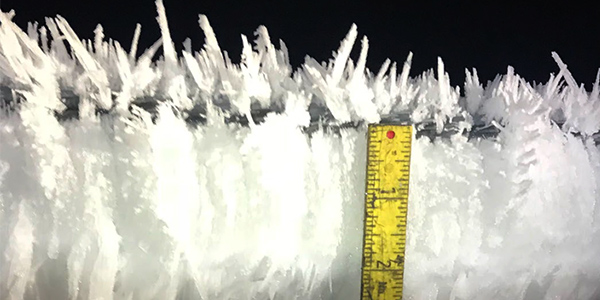By Holden Mann
ATLANTA — SaskPower’s mass outage event of Dec. 4, 2018, was a double shock for the utility. Not only did the disturbance affect nearly 200,000 homes and businesses at its height — ranking as one of Saskatchewan’s worst outages in 40 years — but there seemed to be no immediate cause for the transmission line failures that led multiple generating stations, including the province’s entire coal-fired fleet, to trip offline before emergency crews restored operation.
“In my career at SaskPower, we’ve never seen this, so that’s at least a one-in-26 [years] event,” Wayne Guttormson, manager for interconnections, system planning, asset management and transmission service at SaskPower, told NERC’s Operating Committee last week in a presentation on the utility’s response to the emergency. “Prior to that, I’m unaware of any records that we have for how bad it had gotten.”
Unremarkable Origins
Later investigations found the culprit to be rime ice — a phenomenon in which water droplets in fog cling to a surface and freeze, with additional ice crystals forming on top. Normally, rime ice is quickly melted by the sun or blown away by wind, but on cloudy, calm days, the ice can build up into heavy loads on trees and on overhead shield wires on transmission lines, which do not carry power and hence don’t heat up the way phase conductors do.
By the night of Dec. 3, such conditions had been in effect in Saskatchewan for more than a week, creating what Guttormson called a “perfect storm.” Across the province, ice-burdened shield wires were sagging low enough to contact the phase conductors underneath and cause outages. Usually, such incidents are infrequent, and service is restored quickly once the line is de-energized and the fault is cleared. In this case, more than 100 temporary line outages were associated with sagging shield wires.
What SaskPower hadn’t anticipated was that more than 40 shield wires would break under the strain, beginning around 10:30 p.m. Dec. 3, causing permanent outages until crews could be dispatched to make repairs. Moreover, 34 transmission line structures sustained damage from the sudden release of tension because of broken shield wires; nearly half of these damages were reported as “significant.”
In response, the utility’s protective systems progressively tripped off 14 transmission lines and 10 generating units by the height of the incident around 9 a.m. Dec. 4. This resulted in a brief underfrequency event that lasted for about 10 minutes, after which frequency returned to near normal.
A central theme in Guttormson’s presentation was the importance of devising effective, flexible emergency response and preparedness plans. Though the rapid succession of line outages caught the utility off guard, all distribution points were restored by 11 a.m. Dec. 4, and all transmission lines by 1 p.m. the same day.
The widespread outages gave the impression to outside viewers of a massive system failure, but SaskPower determined afterward that its emergency response procedures had in fact functioned properly. Automated protection systems “operated correctly to prevent a complete system shutdown,” while repair crews responded quickly in the emergency and were well supplied with material. The addition of gas-fired generation alongside traditional coal plants over the past 20 years also contributed to the overall resilience of the system, Guttormson said.
Mitigation, not Prevention
Because such widespread and persistent rime ice formation had never been seen before, SaskPower concluded that the event was “non-preventable.” The utility did identify several systemic risks from aging transmission lines and lattice towers that weren’t designed to withstand shield wire breaks. But the utility said that without foreknowledge of the event, there was no obvious widespread vulnerability that should have been guarded against.
Guttormson acknowledged that the experience gained might help to predict and mitigate future rime ice events. Those are unlikely to occur in the first place, however, as the conditions required — several days of light or no wind or sun, along with heavy fog — are so rare. Rather, the incident is a reminder that utilities cannot hope to anticipate every challenge and must be prepared to respond in the moment, with incomplete information.
“Everyone seems to have [advice], which we’ll certainly take a look at,” Guttormson said. “But in terms of the way the system was coming apart — from a planning perspective, it’s kind of hard to envision those scenarios in some respects, because you just don’t think of all that stuff happening that way in that time frame.”




